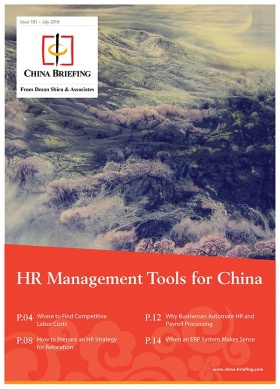What is the Greater Bay Area Plan?
On February 18, Chinese policymakers finally released the blueprint for the development of Guangdong-Hong Kong-Macau Greater Bay Area.
Much anticipated by real estate developers, industrialists, and investors alike, the Greater Bay Area (GBA) has already received plenty of attention for its ambition to transform nine mainland cities and two special administrative regions into a new Silicon Valley-type technology and innovation hub.
That integration would further prop China’s infrastructure and connectivity programs like the Belt and Road Initiative as well as strengthen the supply chain industry in higher-tech manufacturing and services.
Supporting the Greater Bay Area are three key infrastructure projects.
The first is the recently inaugurated Hong Kong-Zhuhai-Macau Bridge, which opened in 2018 and significantly reduces travel times from Hong Kong to Zhuhai and Macau.
The second is the Express Rail Link, which also opened in 2018 and connects Hong Kong to Shenzhen and Guangdong, and subsequently to China’s vast high-speed rail network.
A third project, the Shenzhen-Zhongshan Corridor, is expected to be completed in 2024. It will be an eight-lane highway and will reduce the travel time between Shenzhen and Zhongshan/Jiangmen by approximately 30 minutes.
Commenting on the value of these mega projects, Valeria Manunza, International Business Advisory Assistant Manager at Dezan Shira & Associates’ Guangzhou office, said, “this alignment of infrastructure development is the key to an integrated, efficient, modernized, and rapidly evolving Greater Bay Area”.
WEBINAR – China’s Greater Bay Area: Exploring Key Sectors for Direct Investment and M&A
Tuesday, July 13, 2021 | 4:30 PM Hong Kong / 9:30 AM London
Join us as we bring together a panel of top foreign business experts from four leading China business consulting organizations to address the sector opportunities in the GBA for trade, FDI, and M&A.
Speakers from the Embassy of the People’s Republic of China to the United Kingdom, the 48 Group, China Investment Research, Charltons Law, and Dezan Shira & Associates will discuss the growing number of business and investment opportunities within the GBA, focusing on several key sectors, through keynote presentations, a panel discussion and Q&A session.
Role of the Greater Bay Area in China’s economic development
Once it is physically integrated, the Greater Bay Area will put the region in a stronger position to achieve two other important parts of the initiative: increasing the Chinese economy’s value adding capabilities and boosting internationalization, both of which are important for China’s next stage of economic development.
To foster a region that adds more value in its economy, the initiative plans for the region to become an important global center for advanced manufacturing and to focus on innovation, financial services, transport and logistics, trade, and tourism and leisure.
These are areas where the GBA is already strong, different cities in the region have already established their own unique strengths.

Hong Kong is known as a world financial center; Shenzhen is known as China’s “Silicon Valley” because of its innovation and startup culture; Guangzhou is known for its manufacturing industry and as a logistics hub; and Macau and Zhuhai are known for leisure and tourism.
A more integrated and open GBA allows for the further development of these industries. For example, the completion of the above mentioned key infrastructure projects makes it easier for middle-class consumers to escape to Macau and Zhuhai for the weekend.
Other projects in the pipeline will also help the region to move up the global value chain.
The Guangdong Free Trade Zone will make the region more open to international investment in the targeted industries.
Further to this, in January 2017, China and Hong Kong agreed to build the Lok Mau Chau Loop Technology Park. Located in Hong Kong, right on its border with Shenzhen, the park will allow Hong Kong to tap into Shenzhen’s booming innovation and startup ecosystem while also retaining Hong Kong’s strong legal system and business environment.
The initiative will have international impact beyond the GBA, as the region is located on the maritime section of China’s ambitious Belt and Road Initiative.
Manunza noted, “The region is already China’s most international region, with Guangdong province representing 26 percent of China’s trade and 28 percent of China’s exports.” Adding further, she explained that “A business that is already established in the Pearl River Delta region will be offered the opportunity to expand its range and use the region as a springboard to shift towards a more international approach.”
Companies located in the region that have already made this shift include Chinese tech giants Huawei and Tencent.
As an international city with a highly developed professional services industry and RMB convertibility, Hong Kong can assist Chinese companies to achieve these global ambitions, just as it has traditionally assisted international companies in achieving their ambitions in mainland China.
Integration challenges
A more integrated GBA will help make businesses in the region more competitive as they will be more integrated into both local and global supply chains.
Businesses will also be able to increase their competitiveness by relocating to new development hotspots, such as Zhongshan, Zhaoqing, and Huizhou, where rents and labor costs are lower than Shenzhen and Guangzhou.
For the initiative to be successful and for the whole region to be more internationally competitive, cities in the GBA must move away from unhealthy duplication and low-value manufacturing.
Manunza observed, “The idea is to strengthen the cooperation among the cities within the region by focusing more on their competitive advantages and unique strengths, to create a system in which each city is able to complement one another”. In turn, this will help maximize synergies between the cities.
However, the region will have to overcome silos between cities, especially those between Guangdong province, Macau, and Hong Kong. Currently, the region is less integrated than the European Union (EU).
“A successful GBA project,” Manunza said, “will only arise when each single city in the region is able to prioritize the Bay Area’s benefits over individual ones.”
For example, several sectors in the Chinese mainland are still closed to investment from Hong Kong despite the signing of the Closer Economic Partnership Agreement (CEPA) in 2003.
According to Manunza, important sticking points between the regions include currency use, immigration rules, and corporate tax rates.
Therefore, as well as infrastructure projects, the region will require more harmonized policies and regulations so that goods, services, capital, and people can move more freely within the region.
However, integrating the region’s mainland cities with the two special administrative regions of Hong Kong and Macau not just physically, but with coordinated and complementary laws and policies, is likely the plan’s most controversial aspect.
The special administrative regions enjoy freedoms not seen in mainland China, as well as different legal systems that better protect the rule of law.
Yet, the blueprint says that the GBA should create “an international and market-oriented business environment based on rule of law, under the jurisdiction and legal framework of mainland China.”
Critics of the plan fear that this emphasis on mainland China’s legal and economic systems mean that Hong Kong and Macau’s freedoms and comparative advantages could gradually erode as a result of greater integration.
While the GBA initiative faces an array of practical hurdles, it is clearly ambitious, and offers great potential and opportunities.
If the ambitions of the initiative are realized, the GBA will rival other bay areas in the world and transform the region into a global economic and business hub.
Transformation of the Pearl River Delta
In 1978, China launched a policy of “reform and opening-up”, which catalyzed the economic development of modern-day China. Leading the way in the implementation of this policy was South China’s Pearl River Delta (PRD) region.
Today, the PRD is one of China’s most open and dynamic regions. The PRD is known as “The Factory of the World” and in 2016 the combined GDP of the 11 cities in the region was RMB 9.35 trillion (US$1.38 trillion).
This accounted for 12 percent of China’s economy that year, even though the region accounted for five percent of the country’s population. If the region were a country, it would be the fifth largest economy in Asia.
Despite its success, the Chinese government did not allow the PRD to rest on its laurels.
Facing increasing competition from countries such as India and Vietnam for low-cost manufacturing, the PRD sought to become even more open and innovative by taking a leading role in China’s next stage of economic development.
With the signing of a framework agreement in July 2017 between the National Development and Reform Commission (NDRC) and the governments of Guangdong, Hong Kong, and Macau, the PRD placed itself at the center of an ambitious new initiative.
The initiative, first introduced in China’s 13th Five Year Plan, was to transform the delta into the “Guangdong-Hong Kong-Macau Greater Bay Area” by further integrating Hong Kong, Macau, and nine cities in Guangdong so that they became a world class city cluster.
If the initiative develops according to plan, the region will be transformed from “The Factory of the World” to a dynamic hub of innovation and services with a GDP of US$4.62 trillion by 2030. This could mean the PRD overtaking rival bay areas in Tokyo, New York, and San Francisco to become the biggest in the world in terms of GDP.
Editor’s Note: This article was originally published in February 2018 and has been updated to include latest developments.
About Us
China Briefing is produced by Dezan Shira & Associates. The firm assists foreign investors throughout Asia and maintains offices in China, Hong Kong, Indonesia, Singapore, Russia, and Vietnam. Please contact info@dezshira.com or visit our website at www.dezshira.com.
- Previous Article China’s Pilot Bonded Zone VAT Program
- Next Article 什么是《中国制造2025》,为何它会让世界如此紧张?







